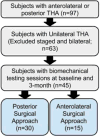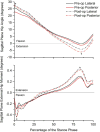The effect of surgical approach on gait mechanics after total hip arthroplasty
- PMID: 29149623
- PMCID: PMC5808892
- DOI: 10.1016/j.jelekin.2017.11.004
The effect of surgical approach on gait mechanics after total hip arthroplasty
Abstract
Background: Few studies have compared the biomechanical outcomes of different surgical approaches for hip arthroplasty. The purpose of this study was to compare hip, pelvic, and trunk kinematics and kinetics between individuals who underwent a posterior or anterolateral approach.
Methods: Forty-five individuals between 40 and 80 years old underwent motion analysis during overground gait prior to hip arthroplasty and 3 months after surgery. Walking speed, hip flexion angle, hip extension angle, adduction angle and moment, trunk angle, trunk lean, and pelvis drop were compared between approaches.
Findings: There were 30 subjects in the posterior group and 15 subjects in the anterolateral group. The groups did not change differently over time as there were no significant interaction effects. However, there were main effects for time; walking speed increased 19.9% (p < .001), hip flexion angle increased 3.3 degrees (p = 0.014) and peak hip extension increased 4.5 degrees (p = .001), and peak hip adduction significantly increased 1.9 degrees (p = .004) for the sample as a whole. Trunk angle (p = .283) and trunk lean (p = .401) did not significantly change between time points, but there was a significant increase in pelvic drop (p = .003).
Interpretation: Surgical approach did not affect biomechanical outcomes 3 months after arthroplasty. Both groups showed improvement in sagittal plane hip kinetics and kinematics. However, increased pelvic drop may be indicative of residual hip weakness in both groups.
Keywords: Hip surgery; Joint replacement; Strength; Trunk lean.
Copyright © 2017 Elsevier Ltd. All rights reserved.
Figures



References
-
- Baker AS, Bitounis VC. Abductor function after total hip replacement. An electromyographic and clinical review. J Bone Joint Surg Br. 1989;71:47–50. - PubMed
-
- Barber TC, Roger DJ, Goodman SB, Schurman DJ. Early outcome of total hip arthroplasty using the direct lateral vs the posterior surgical approach. Orthopedics. 1996;19:873–5. - PubMed
-
- Bhave A, Mont M, Tennis S, Nickey M, Starr R, Etienne G. Functional problems and treatment solutions after total hip and knee joint arthroplasty. J Bone Jt Surg Am. 2005;87(Suppl 2):9–21. - PubMed
Publication types
MeSH terms
Grants and funding
LinkOut - more resources
Full Text Sources
Other Literature Sources
Medical

